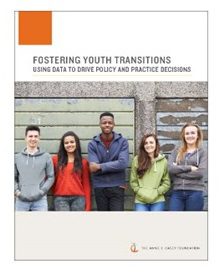 Picture this: You are a first-generation college student, stressed out as you enter your first finals week of your college journey. You are all alone—without the support of parents or adults to help you navigate this important time in your life. In fact, you spent much of your childhood moving from home to home, never really connecting with foster parents or other adults, so you are finding it hard to connect with your advisor, your professors, anyone. You have made a few friendships at college, but no one you can truly trust. You overhear other students talking about their plans for going home for the holidays, the vacations they are taking, the excitement they are feeling for the upcoming break. Because you aged out of foster care when you turned 18, your holiday break will be a time of stress rather than relief: you have no home to go to and don’t know what that time away from school will look like.
Picture this: You are a first-generation college student, stressed out as you enter your first finals week of your college journey. You are all alone—without the support of parents or adults to help you navigate this important time in your life. In fact, you spent much of your childhood moving from home to home, never really connecting with foster parents or other adults, so you are finding it hard to connect with your advisor, your professors, anyone. You have made a few friendships at college, but no one you can truly trust. You overhear other students talking about their plans for going home for the holidays, the vacations they are taking, the excitement they are feeling for the upcoming break. Because you aged out of foster care when you turned 18, your holiday break will be a time of stress rather than relief: you have no home to go to and don’t know what that time away from school will look like.
 This scenario is a reality for many young people. According to the Annie E. Casey Foundation’s recently published brief, Fostering Youth Transitions, the Foundation’s Jim Casey Youth Opportunities Initiative® has found:
This scenario is a reality for many young people. According to the Annie E. Casey Foundation’s recently published brief, Fostering Youth Transitions, the Foundation’s Jim Casey Youth Opportunities Initiative® has found:
- half of older teens who left foster care aged out versus being reunited or connected with a family;
- a third have been removed from their home and placed in foster care multiple times;
- half have experienced three or more foster care placements;
- a third experienced a group home or institutional placement during their most recent stay in foster care; and
- less than a quarter of young people who received federally funded transition services received services for employment, education or housing. (All states receive federal funds to help young people transition from foster care to adulthood.)
The Foundation’s initiative works to improve outcomes for all young people in the United States ages 14 to 26 who have spent at least one day in foster care after their 14th birthday—a population of nearly 1 million. Simply put, children who have been in the foster care system, especially children of color, are falling behind their peers who haven’t been in foster care. This outcome affects the entire nation. What the brief highlights are the negative effects foster care can have on children and how those effects carry through their lifetimes. Examples include academic challenges, disproportionate levels of unemployment and homelessness, and lack of meaningful relationships that children not in the foster care system come to know well.
Take, for instance, the lack of meaningful relationships. Thinking back to the opening paragraph scenario, how does that life experience affect a person in adulthood? How much will that follow them in college, career, and overall regular adult interactions?
What can be done? This brief is asking for state and federal policymakers to take action and make a change. YOU can take a few moments to get informed–the brief offers access to state-level data to see how your own state is doing in this area. One of Casey’s major recommendations is that foster children are able stay in the system until age 21 (currently age 18) so they have time to make those important relationships and can receive guidance at such a pivotal time in their development.
When we all work together with the young adults we come in contact with, it matters. Good Morning America recently ran a story about a critically important school that solely serves foster students, and demonstrates that support and interventions are working for their students. It is a great example of what can be done to help resolve this complex issue. Watch the video (below).
